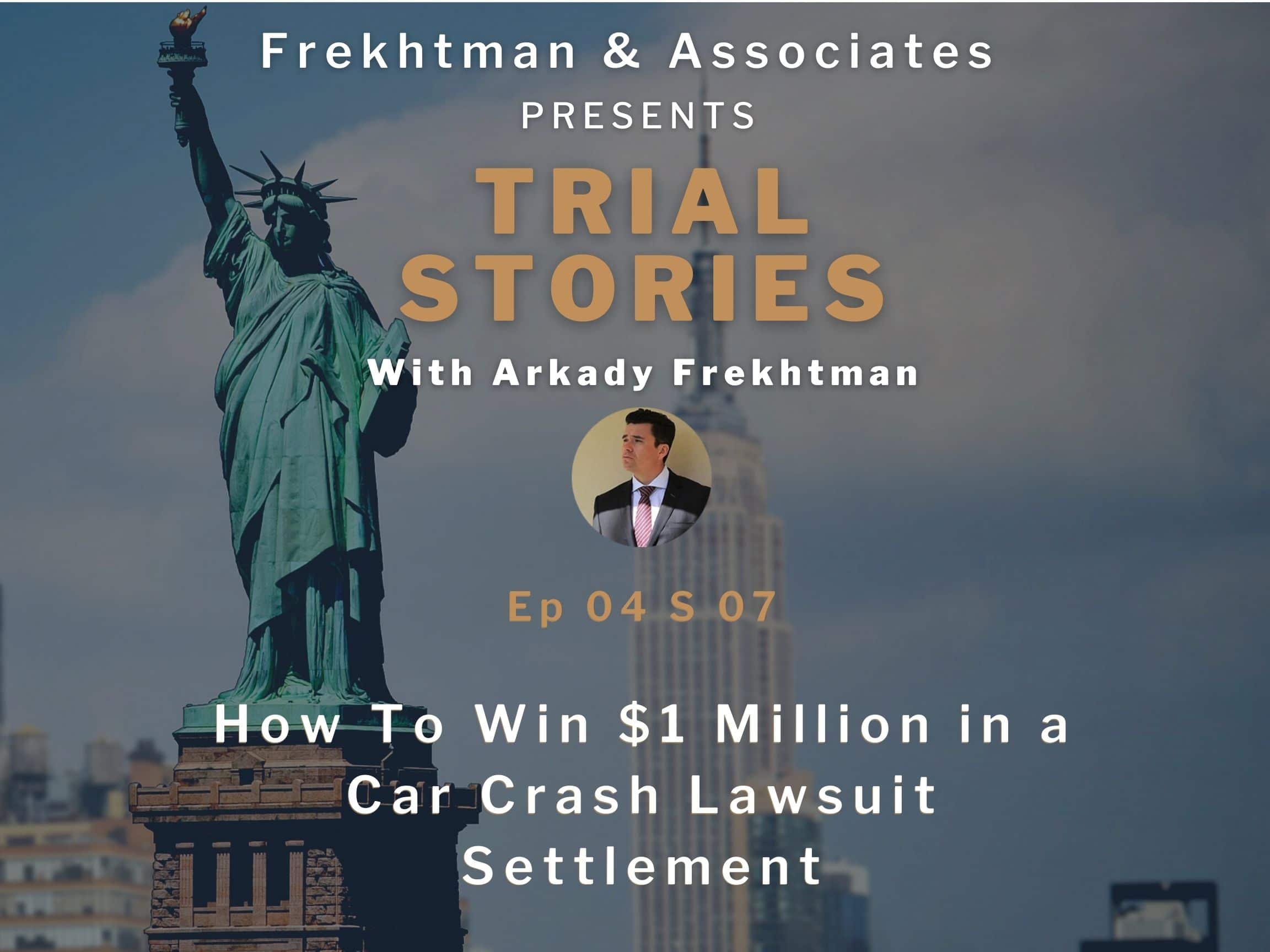EP 04 S 07: How To Win $1 Million in a Car Crash Lawsuit Settlement

Auto/ Car Crash Lawsuit Settled for $1,000,000: Real Case: Find Out How We Did It 🙂
Pick Your Favorite Channel: Apple Podcast | Google Podcasts | Spotify | Stitcher | RSS
Full Transcript
Hi, everybody. My name is Arkady Frekhtman. Today, I wanted to tell you how you can obtain $1 million in a car crash lawsuit. We just did this. We settled a case last week for $1 million. How did we do it? Well, let me tell you a little bit about the case. It was a lady who was crossing the street in the crosswalk. She was 62 years old, and a car struck her. The car struck her pretty hard, and the driver of the car was issued an oath summons for a violation. You’re not supposed to hit a pedestrian in a crosswalk. It was a really clear liability situation. The car happened to have an insurance company. That insurance company had a $1 million policy.
The client, in this case, was a grandmother. She suffered a traumatic brain injury. She actually had a subarachnoid hemorrhage, which is bleeding of the brain. She had a left-sided weakness. Because of the severity of the crash, as a pedestrian, she was knocked down. She hit her head. She had bleeding in the head, and internal bleeding. She had to be hospitalized for an entire week in November 2019. She was hospitalized for an entire week. She was 62 years old.

We are negotiating with you in good faith.” First of all, the insurance company… They started writing us letters back saying, “No, we’re not going to pay that.” First of all, they were saying ridiculous things like, “Oh, you’re saying it’s a brain injury. Well, maybe it’s just going to go away. How do we know it’s not just going to go away?” I don’t know what they’re talking about. But it just shows some of these adjusters who are deciding these cases are just completely… I mean, they have no idea what’s happening with medicine, and they’re not up to date on brain injury science because a brain injury like that does not just go away by itself.
But anyway. This woman had a lot of different things. She had subarachnoid hemorrhages, subdural hematoma, and subdural hemorrhages. She had a hemorrhage along the anterior falx, which is the centerline of the brain, a two-millimeter hemorrhage. She had a four-millimeter subdural hemorrhage of the right frontal convexity. She had a lot of serious injuries. We didn’t only submit the medical evidence, which is confirmed by CAT scan and MRI, FMRI, diffuse tensor imaging, all these neuro-imaging studies. We had that. We had the hospital records. But we also submitted a little bit about her story.

For example, she’s cooking something, and she turns on the gas. Then, her daughter would walk in and say, “Mom, are you cooking something?” She’d say, “No, I’m not cooking anything. Why would you ask?” She’s like, “The gas is on.” She’s like, “Oh, really? The gas is on.” She wouldn’t even know that she had turned the gas on. She would just forget because of the brain injury. In the same vein, sometimes, the children would be playing in the front yard, and she would be tasked with watching them. But they couldn’t do that anymore because, in the front yard, in Brooklyn, there are cars whizzing by just a few steps from the road. With her brain injury, she can’t be the only adult watching these children because it’s potentially dangerous. Everything changed, not just for her but for the entire family. That’s why we correlated that.
I think that’s very important for a lawyer to do: to clinically correlate those stories with the medical records. Because if you just say subarachnoid hemorrhage, people won’t even know what that is. But if you explain, “Hey, it’s a brain bleed, and it’s affecting the left side. Now, she’s weak in the left side. Now, she has short term memory loss,” then the stories like the gas being on watching the children, they really become powerful.

Then, they said, “Okay. We’re going to fire our in-house counsel. This is not the case for in-house council. But we’re going to hire a more reputable outside third-party litigation firm that works with our insurance company as well as other insurance companies.” They have really top-notch trial lawyers.” They put in that firm. Then, that firm started investigating the case. That firm started litigating the case instead of the in-house counsel. That’s the first thing that happened.
Then, a few months later, we got a call. You have to check if it was the same adjuster or a different adjuster. But they just basically said, “You know what? We’re going to tender. We’re going to give you the million.” At that point, I spoke with the client. Actually, I didn’t want to take it. I said, “Look, the deadline passed.” I mean, it wasn’t that much beyond the 30 days. But I said, “Look, the deadline passed. If we go to court, and we hit them for more than a million, we may have a strong bad faith claim. Even though, New York, bad faith law isn’t as good as other states we have true bad faith. But I said, “We have to stick to our guns.” But the client said, “Look, I mean, I really need the money. I don’t want to wait.” We haven’t even had any depositions yet. This is just starting. Because of that, the client said, “Let’s take it.” We settled it. We got the million dollars.

But anyway. But what the point is, what they try to do is, the insurance companies, is that they tell you, “Counselor, you’re the lawyer for the plaintiff. What’s your demand? Give me your demand.” Now, if you call them up, and you say, “Okay, I have a brain injury. My demand is a million…” Or some lawyers will be scared to even say that. They’ll say, “My demand is 950,” because they think they’re doing them a favor. But as soon as you say that, there’s no way you’re getting 950. There’s no way you’re getting a million. Usually, what they’re going to do is they’re going to offer you maybe 200,000, 300,000. Because as soon as you say 950, they whittle you down.
There’s something known as the rule of three. They pretty much take your demand, and they cut it in three. They think, “Oh. If you’re asking for nine, that means you’ll probably take three.” Then, they’ll offer you 150. Why? Because they figure, “Oh, we’ll offer them 150. Maybe we’ll get them up to two. We can park it at 250/275 maybe, or if we have to, we’ll pay them 3/325. That’s their whole game. They want to whittle you down to nothing or to as low as possible because insurance companies just want to pay out as little money as possible, manage their risk, and you can never go back up. Once you say 950, you can never go to 975. If you do, they’ll scream, and they’ll holler. They’ll tell the judge. They’ll say, “Wait a minute! Mr. Frekhtman demanded 950 on January 17th, 2021. Now, he’s saying 960. Nowhere!” Their heads will explode.

Maybe I’ll do another video. I’ll get into all the nitty-gritty about this case, the actual elements of bad faith that we cited in the letter. I could talk about the liability, although it was very clear. As I said, she was hit in the crosswalk. I could talk more about the damages, some of the stories, and some of the medical evidence. But I thought, overall, this was a good result. It happened fairly quickly. I believe from the letter until the settlement, maybe it was… I mean, it wasn’t a month. It was definitely a few months, maybe even closer to a year, because they needed maybe some time to review everything.
The client was still getting treatment. But I thought it was definitely quicker because of this case… If we had not settled, if we said, “Look, let’s go…” We’d have to do the deposition of the plaintiff. She may have not been able to be deposed cause of the brain injury. Someone else, like a family member, would have to be a guardian. Do depositions: put it on the trial calendar. Depositions of the defendant: put it on the trial calendar. Motions, like summary judgment: wait until the case will be called for trial. You’re probably looking at… I don’t know, 2023 on a good day, maybe 2024 until you would have a trial.
Then, essentially, at trial, if you did hit for 5 million or whatever, they’d probably just say, “Look, all we have is a million. That’s the policy. There’s no excess,” and just pay you the million. In that sense, this was a good result for the client because she got the full million. It was done quickly. We put pressure on them. I think that’s what lawyers have to do to win these cases.
I hope this has been helpful. Let us know what questions you have. We’re here for you. Have a great day. Okay. Talk to you soon. Bye-bye.
Get Legal Help in New York
If you have suffered a personal injury due to someone else’s negligence, you need to contact our specialized lawyers. We will carefully investigate all the facts of your case, review all your medical records, and then fight hard to win the maximum compensation available to you. We want every client to fully recover for all lost wages, pain and suffering, medical expenses, and other losses.
Video Version:

▶▶ CALL US NOW – FREE EVALUATION
(212) 222-1111 or (866) ATTY LAW
▶▶ CONTACT US NOW – FREE EVALUATION
https://866attylaw.com/contact-us/




